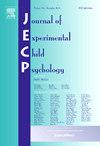Comparison between young children’s and college students’ cooperative success in an online Stag Hunt: Do prior training, sex, relationship, and nature of communication matter?
IF 1.8
2区 心理学
Q3 PSYCHOLOGY, DEVELOPMENTAL
引用次数: 0
Abstract
Cooperation is an important feature of human lives and society. Understanding the underlying social-contextual factors of differences in cooperative success across different ages is therefore crucial for understanding human development. The Stag Hunt is a widely used paradigm for studying cooperation. However, results of previous studies with young children and college students playing the Stag Hunt are difficult to compare because of methodological differences. The main goal of the current study was to compare cooperative success between children (136 dyads, M = 8.1 years) and college students (113 dyads, M = 22.8 years) using an online version of a coordination game, the Stag Hunt, with 10 trials, including versions with and without prior training on the reward structure. College students showed better abilities to cooperate compared to children. In addition, prior training improved overall cooperation, but the effect of training declined over the trials, while untrained college students, but not children, gradually learned to cooperate. Players’ sex and relationship type did not affect cooperation. The nature of communication during the game, however, played an important role in the cooperative success of both children and students, with communication about the reward structure improving cooperation and competitive expressions hindering it. Finally, communication unrelated to the game did not affect cooperative success in children and college students. The current study therefore highlights the importance of age, prior knowledge, and nature of the communication in coordination processes. Future research should take these into account when designing tasks and interpreting the results.
幼儿与大学生在网络猎鹿游戏中合作成功的比较:先前的训练、性别、关系和沟通的性质有影响吗?
合作是人类生活和社会的一个重要特征。因此,了解不同年龄段合作成功差异的潜在社会背景因素对于理解人类发展至关重要。猎鹿是研究合作的一个广泛使用的范例。然而,由于方法上的差异,之前对幼儿和大学生玩猎鹿游戏的研究结果很难进行比较。当前研究的主要目标是比较儿童(136对,M = 8.1岁)和大学生(113对,M = 22.8岁)之间的合作成功,他们使用了一个在线版的协调游戏,猎鹿游戏,有10个试验,包括有和没有事先训练奖励结构的版本。与儿童相比,大学生表现出更好的合作能力。此外,先前的训练提高了整体的合作能力,但训练的效果随着试验的进行而下降,而未受过训练的大学生逐渐学会了合作,而不是儿童。玩家的性别和关系类型对合作没有影响。然而,游戏中交流的性质对儿童和学生的合作成功都起着重要的作用,关于奖励结构的交流促进了合作,而竞争性表达则阻碍了合作。最后,与游戏无关的交流对儿童和大学生的合作成功没有影响。因此,当前的研究强调了年龄、先验知识和协调过程中沟通的性质的重要性。未来的研究在设计任务和解释结果时应该考虑到这些因素。
本文章由计算机程序翻译,如有差异,请以英文原文为准。
求助全文
约1分钟内获得全文
求助全文
来源期刊

Journal of Experimental Child Psychology
Multiple-
CiteScore
4.50
自引率
7.70%
发文量
190
期刊介绍:
The Journal of Experimental Child Psychology is an excellent source of information concerning all aspects of the development of children. It includes empirical psychological research on cognitive, social/emotional, and physical development. In addition, the journal periodically publishes Special Topic issues.
 求助内容:
求助内容: 应助结果提醒方式:
应助结果提醒方式:


